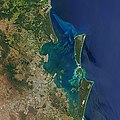File:Sandy Shores of Moreton Bay.jpg

Size of this preview: 600 × 600 pixels. Other resolutions: 240 × 240 pixels | 480 × 480 pixels | 768 × 768 pixels | 1,024 × 1,024 pixels | 2,048 × 2,048 pixels | 7,478 × 7,478 pixels.
Original file (7,478 × 7,478 pixels, file size: 18.18 MB, MIME type: image/jpeg)
| This is a featured picture, which means that members of the community have identified it as one of the finest images on the English Wikipedia, adding significantly to its accompanying article. If you have a different image of similar quality, be sure to upload it using the proper free license tag, add it to a relevant article, and nominate it. |
| This image was selected as picture of the day on the English Wikipedia for October 6, 2023. |
File history
Click on a date/time to view the file as it appeared at that time.
| Date/Time | Thumbnail | Dimensions | User | Comment | |
|---|---|---|---|---|---|
| current | 09:14, 10 February 2021 |  | 7,478 × 7,478 (18.18 MB) | StellarHalo | Uploaded a work by NASA Earth Observatory image by Joshua Stevens, using Landsat data from the U.S. Geological Survey. Story by Kasha Patel. from https://earthobservatory.nasa.gov/images/146776/sandy-shores-of-moreton-bay with UploadWizard |
File usage
The following pages on the English Wikipedia use this file (pages on other projects are not listed):
- Brisbane
- Eastern shovelnose ray
- Moreton Bay
- User talk:201.163.50.204
- User talk:MER-C/archives/55
- Wikipedia:Featured picture candidates/April-2021
- Wikipedia:Featured picture candidates/Moreton Bay
- Wikipedia:Featured pictures/Space/Looking back
- Wikipedia:Featured pictures thumbs/70
- Wikipedia:Main Page history/2023 October 6
- Wikipedia:Main Page history/2023 October 6b
- Wikipedia:Picture of the day/October 2023
- Wikipedia:WikiProject Australia/2.0/About
- Wikipedia:WikiProject Australia/Featured and good content
- Template:POTD/2023-10-06
- Portal:Australia/Content
Global file usage
The following other wikis use this file:
- Usage on id.wikipedia.org
- Usage on ja.wikipedia.org
- Usage on ms.wikipedia.org
- Usage on sat.wikipedia.org


